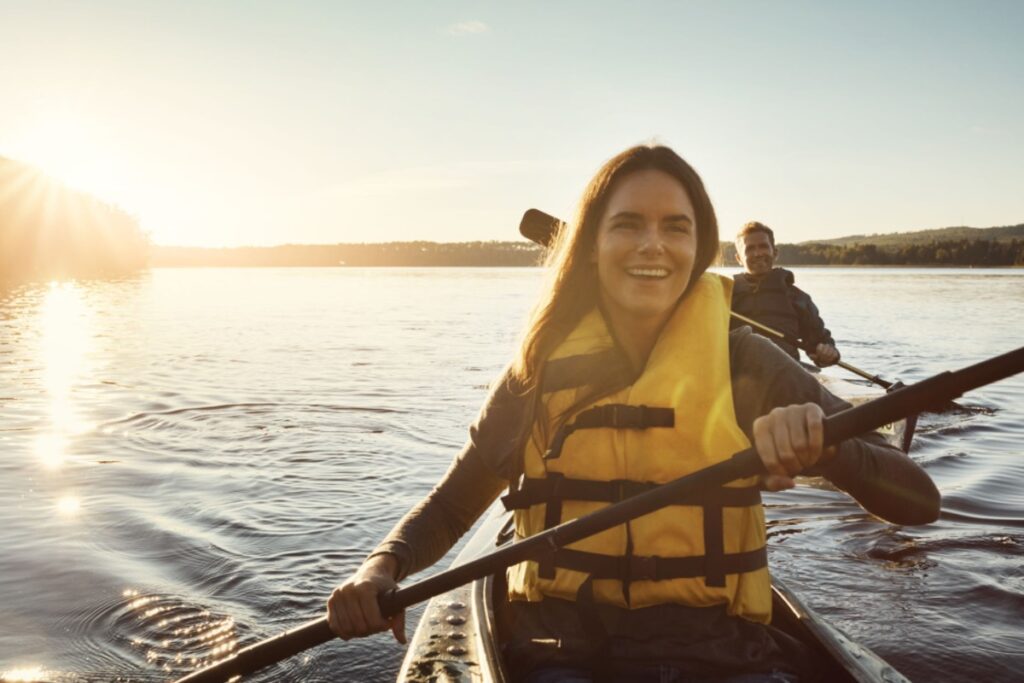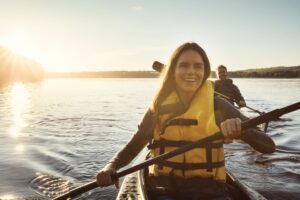My name is Todd, and I am an adventurer at heart, with a deep-seated passion for kayaking and camping that spans over two decades.
My love affair with the outdoors started in my youth, and over time, kayaking has turned from a simple hobby into a way of life.
With countless hours paddling in serene lakes, navigating through thrilling whitewater rapids, and setting up camps on remote shores, I’ve collected a wealth of knowledge, experiences, and a fair share of unforgettable stories along the way.
Now, why am I sharing all this with you?
Simply put, I want to pass on the baton of knowledge and help you unlock the exciting world of kayaking. This blog post isn’t just another write-up; it’s a comprehensive guide that aims to answer what is kayaking, styles and types of kayaks, gear and brands, and more.
Whether you’re a complete beginner just getting your feet wet or a seasoned paddler looking to refine your skills, there’s something in here for you.
In this guide, we’ll paddle through the basics and then dive into the nitty-gritty details – types of kayaks, essential gear, key techniques, safety measures, and even how you can couple kayaking with camping for the ultimate outdoor experience.
So buckle up, grab your paddles, and let’s embark on this journey together!
What is Kayaking?
Kayaking is a versatile water sport that involves maneuvering a small boat, known as a kayak, using a double-bladed paddle.
But to me, and to many others who’ve discovered its allure, it’s much more than just a sport. It’s a captivating blend of adventure, tranquility, physical challenge, and the chance to immerse oneself in nature’s grandeur.
The roots of kayaking trace back over 4,000 years to the Inuit peoples of the Arctic regions.
The term ‘kayak’ itself means “man’s boat” or “hunter’s boat,” and true to its name, the Inuit used these sturdy vessels for hunting and fishing.
The original kayaks were made from driftwood or whalebone frames covered with stitched seal or other animal skins, offering a lightweight yet sturdy solution for navigating icy waters.
Fast forward to the modern era, and the humble kayak has evolved into myriad forms and styles to suit diverse needs. The advancements in technology and design have also made kayaking more accessible to the masses, contributing to its popularity.
Styles of Kayaking
Throughout my paddling journey, I’ve had the privilege of experiencing the diverse styles of kayaking.
Each type presents its unique set of challenges and rewards. Let me introduce you to the six main types that you’re likely to encounter.
Sea Kayaking
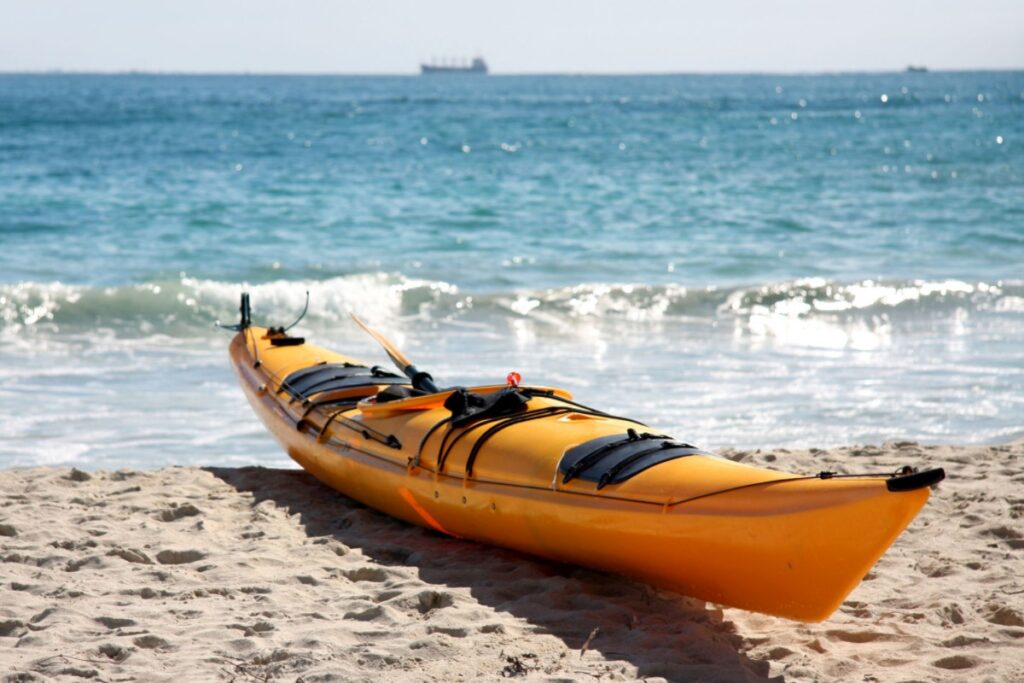
Sea kayaking, or touring kayaking, is all about long-distance travel and exploration. It’s a fantastic way to enjoy coastal scenery, visit remote islands, or even spot wildlife. My own sea kayaking adventures have taken me from the rugged coastlines of British Columbia to the sun-drenched shores of Greece, each trip revealing unique landscapes and experiences.
Sea kayaks are typically longer and more streamlined for efficient paddling over distance. They also have a closed deck and storage compartments for gear and supplies, making them an excellent choice for multi-day trips.
Whitewater Kayaking
For those drawn to adrenaline-pumping action, whitewater kayaking is the answer. It involves navigating through turbulent river rapids with swift currents, big waves, and sometimes even waterfalls. My first taste of whitewater kayaking was a baptism by fire in Colorado’s Arkansas River, and the thrill it brought was nothing short of addictive.
Whitewater kayaks are smaller, sturdier, and highly maneuverable. Their design enables paddlers to perform technical moves and quickly respond to the river’s changing dynamics.
Recreational Kayaking
Recreational kayaking is perhaps the most accessible type, designed for calm waters like lakes, slow-moving rivers, or protected coastal areas. I find it an ideal choice for leisurely outings, wildlife watching, or simply enjoying a quiet paddle on a serene lake near my home.
Recreational kayaks are typically wider for stability, have a large open cockpit for easy entry and exit, and are best for short trips and casual paddlers.
Fishing Kayaking
Fishing kayaking is a fusion of the age-old practice of fishing and the thrill of being on a kayak. I’ve spent countless dawn hours casting lines into tranquil lakes and rivers from a kayak, with only the call of loons or the gentle lap of water breaking the silence. The intimacy of water-level fishing in an environment that larger boats can’t reach is an experience every angler should have.
Fishing kayaks are stable, enabling you to cast and reel without capsizing. They also come equipped with specialized features like rod holders, tackle storage areas, and even fish finders. Whether it’s freshwater or saltwater fishing, kayaking adds an extra layer of adventure to the experience.
Surf Kayaking
Surf kayaking is another exhilarating style that combines elements of surfing and kayaking. Instead of a surfboard, you’ll be catching waves on a kayak! My first time surf kayaking off the coast of California was an unforgettable experience – the thrill of riding a wave, the taste of saltwater, and the sound of crashing surf.
Surf kayaks are designed with a flat bottom and sharp edges to carve turns on the face of a wave. It’s a unique style that demands a combination of kayaking skills and an understanding of surf.
Expedition Kayaking
Expedition kayaking involves long-distance journeys that can span hundreds of miles and last for days or even weeks.
I’ve undertaken a few expedition trips myself, and they were as much a journey of self-discovery as they were about exploring the waterways. These expeditions take you away from the buzz of civilization and immerse you in the raw beauty of nature, but it is not for the faint of heart.
Expedition kayaks are akin to sea kayaks but with more storage capacity for carrying food, camping gear, and other necessities for extended trips. Preparing for and undertaking a kayak expedition is a serious endeavor, but the rewards are truly worth the effort.
Where a sea kayak might be considered like a day hike, expedition kayaking is more comparable to a thru-hiking journey.
The beauty of kayaking is that there’s a style for everyone, each offering a unique way to connect with the water and nature.
Whether you’re chasing the thrill of riding a wave, the tranquility of a fishing trip, or the adventure of a long-distance expedition, kayaking invites you to explore these possibilities and more.
Each style of kayaking offers a unique perspective on the world and a unique set of challenges. And trust me, whether you’re gliding peacefully across a still lake or navigating heart-pounding rapids, the experience will leave you wanting more.
The Parts of a Kayak
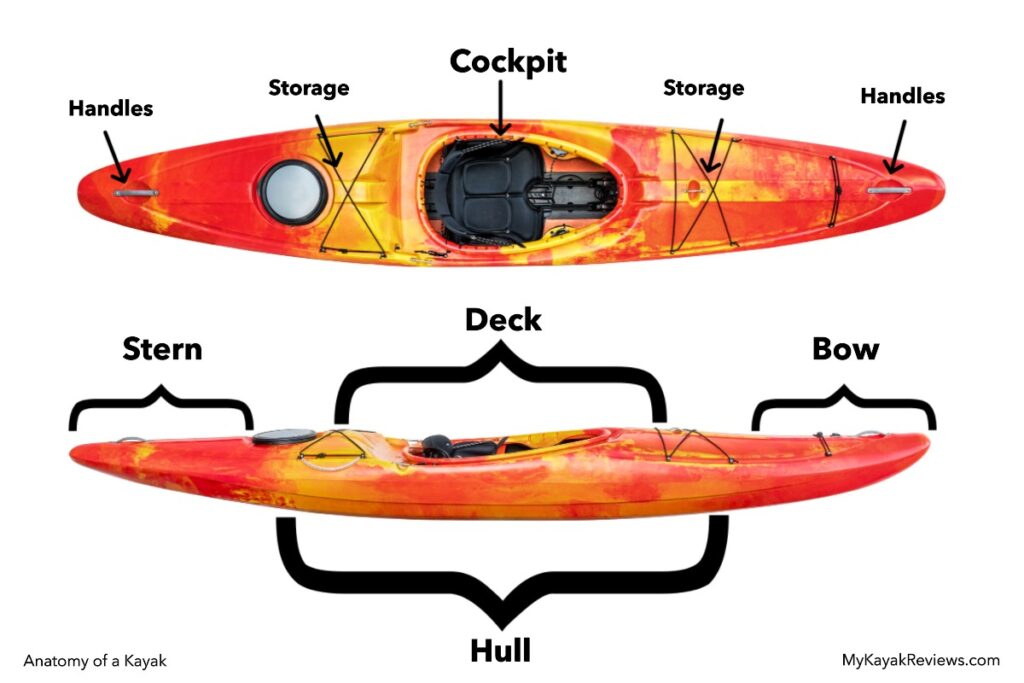
To appreciate kayaking and master the craft, it’s essential to understand the anatomy of a kayak.
Much like how knowing the parts of a bicycle helps you ride better, getting familiar with the various components of a kayak will make you a more informed and competent paddler.
Let’s dissect a kayak and delve into its key parts, each with a unique role in how the kayak behaves in the water.
Hull
The hull is the bottom part of the kayak that sits in the water. It’s the primary factor determining the kayak’s stability and speed.
There are two main types of hulls: flat and rounded.
Flat hulls, often found on recreational and fishing kayaks, provide great initial stability, making it harder to tip over.
Rounded hulls, more common on sea and whitewater kayaks, offer less initial stability but greater secondary stability, enabling them to handle rough waters and edge effectively.
Deck
The deck is the top of the kayak, designed to keep water out of the interior. Many sea and expedition kayaks have a deck outfitted with bungee cords or hatches for storing gear.
Cockpit
The cockpit is where you sit and control the kayak. The size and design vary depending on the kayak type.
Sea and whitewater kayaks often have smaller cockpits to allow better control and to keep water out, while recreational kayaks have larger, open cockpits for easy entry and exit.
Bow and Stern
The bow is the front end of the kayak, and the stern is the back end. The shape and length of these can greatly influence a kayak’s speed, maneuverability, and tracking (the ability to maintain a straight line).
Longer bows and sterns generally improve speed and tracking but reduce maneuverability, which is why you’ll find them on sea and touring kayaks.
On the other hand, whitewater kayaks have shorter and often more rockered (upturned) bows and sterns for agility and quick turns.
What Materials Kayaks are Made Of

Kayaks, originally developed by the indigenous Inuit people of the Arctic regions, were traditionally constructed from driftwood or whalebone and covered with sealskin to keep them buoyant and water-resistant.
Nowadays, the materials used for kayak construction have significantly advanced to adapt to the performance needs of modern paddlers. The most common materials used in the construction of modern kayaks include roto-molded polyethylene, thermoformed plastic, ABS plastic, fiberglass, Kevlar, carbon fiber, and wood.
Roto-molded polyethylene is widely used due to its durability and affordability, though it is relatively heavier.
Thermoformed plastic and ABS plastic kayaks sit at the mid-range level, offering a balance between weight and durability.
Fiberglass, Kevlar, and carbon fiber kayaks are lighter and faster but require more careful handling due to their susceptibility to damage. Wood, used in more traditional or home-built kayaks, provides a beautiful finish and a fair degree of toughness.
Modern kayaks are varied in design, from the traditional closed-deck designs to sit-on-top models, inflatable kayaks, and foldable options.
These designs are often purpose-specific and tailored for a range of kayaking activities, such as recreational paddling, touring, sea kayaking, whitewater kayaking, and fishing.
Features such as hull shape, cockpit design, length, width, and storage compartments are carefully engineered to enhance performance, stability, speed, and maneuverability in specific water conditions.
Today’s kayaks not only reflect the profound technological advancements in material science but also the growing versatility of the sport and outdoor activity itself.
Over the years, I’ve paddled kayaks made from different materials, each offering distinct advantages and drawbacks.
Plastic (Polyethylene)
Plastic, specifically polyethylene, is the most common material used in modern kayaks.
It’s durable, resistant to impact, and inexpensive, making it a popular choice for beginners and recreational kayakers.
However, plastic kayaks are heavier and less efficient in the water compared to their composite counterparts.
Pros of Plastic (Polyethylene) Kayaks
- Affordability: Polyethylene kayaks are typically less expensive than their composite counterparts. This makes them more accessible for those on a tight budget, or for those just starting out and not willing to invest heavily.
- Durability: Plastic kayaks are known for their robustness. They can take a beating without puncturing or cracking. Impacts with rocks, drops, and groundings that might damage a composite kayak often only leave minor scratches on a plastic model.
- Easy Repairs: While these kayaks are less prone to damage, when it does occur, they’re generally easier to repair than composite kayaks. This can often be done with a simple plastic welding kit.
- UV Resistance: While all kayaks should ideally be stored out of direct sunlight, plastic kayaks are more resistant to UV damage than composites, although they can still degrade over time if left in the sun.
- Versatility: Plastic kayaks are typically more versatile. They can handle a variety of conditions, from calm lakes to whitewater rivers, and are especially suited to rocky or obstacle-strewn environments where their durability shines.
Cons of Plastic (Polyethylene) Kayaks
- Weight: Polyethylene kayaks are generally heavier than composite kayaks. This can make them harder to transport and require more effort to paddle, particularly over longer distances.
- Performance: Plastic kayaks often lack the speed, glide, and sharp handling characteristics of their composite counterparts. This could be a downside for experienced kayakers or those who prefer long-distance touring or racing.
- Shape Deformation: Plastic kayaks can warp over time, especially if stored improperly or left in high temperatures. This can affect their performance and aesthetics.
- Environmental Impact: While this is more of a long-term concern, it’s worth noting that polyethylene is a petroleum-based product and not as environmentally friendly to manufacture or dispose of as some other materials.
- Limited Design Options: Plastic kayaks, particularly those that are rotomolded, may not offer the same variety of shapes and styles as composite kayaks. This could limit performance enhancements that come from specialized hull designs.
Composite
Composite kayaks are made from materials like fiberglass, carbon fiber, or Kevlar. These materials make the kayak lighter and more efficient in the water, offering better speed and maneuverability.
These types of kayaks are more expensive and less durable than plastic kayaks. My first sea kayak was a fiberglass Dagger model, and I still remember how smoothly it cut through the rocky ocean waves.
Pros of Composite Kayaks
- Performance: Composite kayaks are typically more performance-oriented than their plastic counterparts. They have superior glide, speed, and maneuverability, allowing the paddler to cover longer distances with less effort. This makes them ideal for serious touring, racing, and sea kayaking.
- Weight: These kayaks are lighter than their polyethylene counterparts. This makes them easier to carry to and from the water and more efficient to paddle, particularly on longer trips.
- Rigidity: Composite materials result in a stiffer kayak. This rigidity translates into better transfer of power from paddle strokes to forward motion and less flexing of the hull when loaded with gear, contributing to better overall performance.
- Design Flexibility: Composite construction allows manufacturers to create sleeker, more hydrodynamic shapes, with sharper entry and exit lines, which are not always possible with rotomolded plastic.
- Durability Over Time: While initial damage can be easier to incur, composite kayaks are not as susceptible to warping or UV damage as plastic ones, ensuring they maintain their shape and performance characteristics over time.
Cons of Composite Kayaks
- Cost: Composite kayaks are typically more expensive to manufacture and purchase than polyethylene models. This could put them out of reach for budget-conscious consumers or beginner paddlers who aren’t ready to invest in a high-end model.
- Damage Susceptibility: These kayaks can be more vulnerable to impact damage. Hitting a rock or dropping the kayak can crack or puncture the hull, while plastic kayaks tend to bounce or deform without breaking.
- Repair Complexity: While it’s possible to repair a composite kayak, it usually requires a higher level of skill and specialized materials compared to plastic kayak repairs. This can lead to higher repair costs if you can’t do it yourself.
- Lack of Flexibility: Composite kayaks are stiff, which is generally a good thing, but it can also mean they are less forgiving in rough or rocky conditions where some flex could help absorb impacts.
- Care and Storage: Composite kayaks typically require more careful handling and storage than plastic ones. They should ideally be stored inside, or at least covered, to protect the material from UV radiation and extreme temperatures.
Inflatable
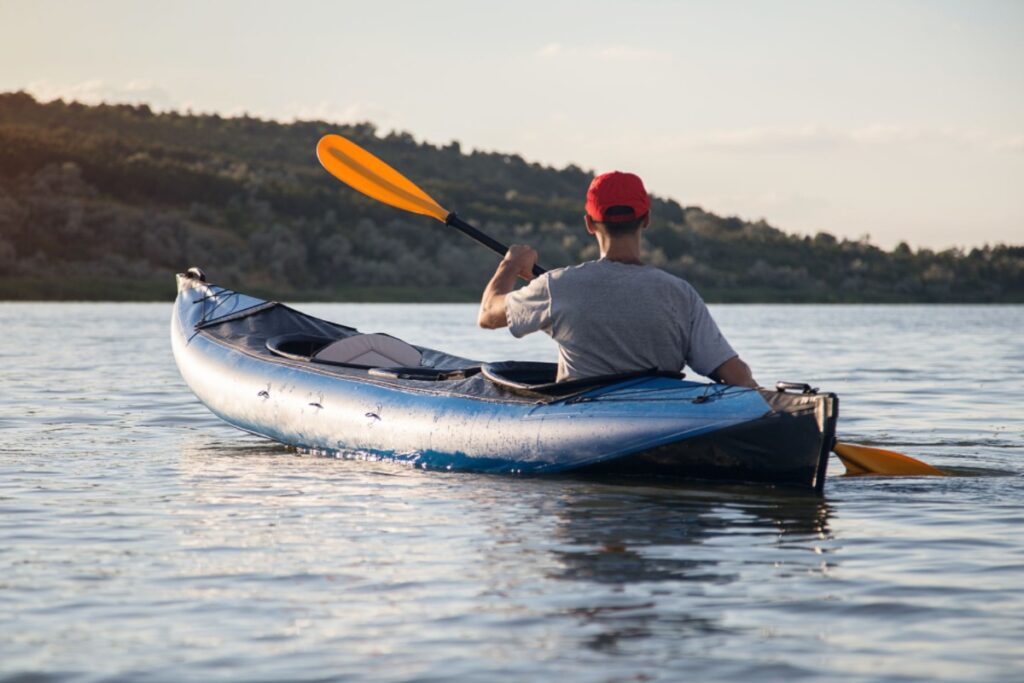
Inflatable kayaks are made from durable synthetic materials that can be inflated for use and deflated for easy storage and transport. They’re perfect for those with limited storage space or for taking on travels.
While not as performance-oriented as rigid kayaks, modern inflatable kayaks can surprise you with their stability and durability.
Pros of Inflatable Kayaks
- Portability: Inflatable kayaks are lightweight and easily deflatable, making them highly portable and convenient for storage and transportation.
- Easy Storage: Deflated inflatable kayaks can be folded into a compact size, requiring minimal storage space compared to rigid kayaks, making them ideal for those with limited storage options.
- Versatility: Inflatable kayaks can be used in various water environments, including rivers, lakes, and calm coastal waters, providing versatility for different kayaking adventures.
- Durability: High-quality inflatable kayaks are designed to be puncture-resistant and made from durable materials, allowing them to withstand common challenges like rocks or tree branches in the water.
- Affordability: Inflatable kayaks are generally more affordable than rigid kayaks, making them a budget-friendly option for beginners or casual kayakers.
- Beginner-Friendly: The stability of inflatable kayaks can make them more forgiving for novice kayakers, providing a comfortable and stable platform for learning basic kayaking skills.
- Easy Set-up: Inflatable kayaks can be quickly inflated using a pump, allowing users to hit the water faster and with minimal effort compared to assembling a rigid kayak.
- Comfort: Inflatable kayaks often feature adjustable seats and backrests, providing enhanced comfort during long hours of kayaking.
Cons of Inflatable Kayaks
- Stability: Compared to rigid kayaks, inflatable kayaks can be less stable, especially in rough water conditions, which may require additional caution and balance skills.
- Performance Limitations: Inflatable kayaks have slower speed and less precise tracking than rigid kayaks, limiting their performance capabilities for advanced or high-speed kayaking.
- Set-up and Breakdown Time: Inflatable kayaks require inflation and deflation, which can take some time and effort, especially if you don’t have access to an electric pump.
- Susceptible to Damage: While inflatable kayaks are designed to be durable, they can still be susceptible to punctures or damage from sharp objects, requiring care and caution when navigating certain water environments.
- Limited Load Capacity: Inflatable kayaks often have lower weight capacity compared to rigid kayaks, limiting the amount of gear or passengers that can be carried, which may not be suitable for longer trips or group outings.
- Tracking and Maneuverability: Inflatable kayaks may have slightly less precise tracking and maneuverability compared to rigid kayaks, which can impact their performance in strong currents or tight spaces.
- Perception: Some kayakers may view inflatable kayaks as less durable or less authentic compared to traditional hard-shell kayaks, which could influence personal satisfaction or acceptance within certain kayaking communities.
- Maintenance: Proper cleaning, drying, and storage are essential to prevent mold or mildew in inflatable kayaks, requiring additional maintenance compared to rigid kayaks.
Kayak Design and Performance
The design of a kayak is a balance between competing factors – speed, stability, maneuverability, and tracking.
As you gain experience kayaking, you’ll learn to appreciate how these factors influence a kayak’s behavior.
Speed vs. Stability
Narrower and longer kayaks are generally faster but less stable, while wider and shorter kayaks are more stable but slower.
For instance, a sleek, long sea kayak can cover distance efficiently, but its slim design might feel tippy to a beginner.
Conversely, a wide recreational kayak offers excellent stability, ideal for beginners or photographers, but won’t win any races.
Maneuverability vs. Tracking
Kayaks with a shorter length and more rocker (the curve from bow to stern) turn more easily, which is desirable in whitewater or surf environments.
However, this design tends to make the kayak veer off a straight line, requiring more effort to keep on track.
On the other hand, longer kayaks with less rocker stay on a straight path – or track – more readily, but they’re less agile. That’s why touring and sea kayaks are typically long and straight, helping them maintain course during long paddles.
Primary vs. Secondary Stability
Primary stability refers to how stable the kayak feels when you’re sitting flat on calm water, whereas secondary stability describes how stable it feels when tilted on edge, like when you’re carving a turn or riding a wave.
Generally, flat-bottomed kayaks have high primary stability but less secondary stability, making them great for flat water but potentially unstable in rough conditions.
Rounded or V-shaped hulls might feel a bit tippy initially (less primary stability) but provide strong support when leaning or in waves (high secondary stability).
The key is understanding these trade-offs to select a kayak that suits your specific needs and paddling environment.
I recall when I transitioned from a flat-bottomed recreational kayak to a sea kayak with a rounded hull – initially, it felt unnervingly unstable, but that very design made it responsive and seaworthy, allowing me to venture further with confidence.
A kayak is more than just a boat; it’s a carefully designed vessel that balances several performance aspects. By understanding how it works and the factors influencing its behavior, you can truly become an experienced kayaker.
Types of Kayaks & Their Uses
Kayaking’s broad appeal is partly due to the variety of kayaks designed to cater to different needs, conditions, and preferences. I’ve had the pleasure (and sometimes, the challenge) of paddling different types of kayaks over the years. Let’s explore some of the common types you’ll come across.
Sit-On-Top Kayaks
Sit-on-top kayaks, as the name suggests, have an open deck where you sit on top rather than inside a cockpit. This design makes them exceptionally user-friendly – easy to get on and off, and there’s no need to worry about being trapped inside if you capsize. I particularly enjoy them for leisurely paddles, fishing, snorkeling, or paddling with my dog.
However, they offer less protection from the elements, so they’re better suited for warm environments. Some great sit-on-top models are the Perception Pescador Pro for fishing or the Ocean Kayak Malibu for recreational use.
Sit-In Kayaks
Sit-in kayaks have a cockpit that you sit inside, which provides better protection from the water and wind, allowing for more efficient paddling. I’ve found them well-suited for cooler conditions, longer trips, and when I want more control over the kayak, like when sea kayaking or touring.
The downside is that recovery from a capsize requires specific skills. For a versatile sit-in kayak, you might consider models like the Dagger Axis or the Wilderness Systems Tsunami.
Inflatable Kayaks
Inflatable kayaks, made of tough, puncture-resistant material, are perfect when storage or transport is a concern. They are surprisingly stable and capable, and I’ve even taken mine down some moderate rapids! However, they might not perform as well as hard-shell kayaks in terms of speed and tracking.
If convenience is your top priority, the Advanced Elements AdvancedFrame and the Sea Eagle 370 are excellent inflatable models.
Tandem Kayaks
Tandem kayaks, or two-person kayaks, are a fantastic way to share the paddling experience with a partner. They’re great for families, couples, or anyone who prefers company. Just remember, coordination is key, or you’ll be going in circles – I learned this the hard way on a trip with a friend!
However, they are larger and heavier, making them a challenge to transport and handle alone. For tandem models, I recommend the Perception Tribe Tandem for sit-on-top and the Old Town Dirigo Tandem for sit-in style.
Fishing Kayaks
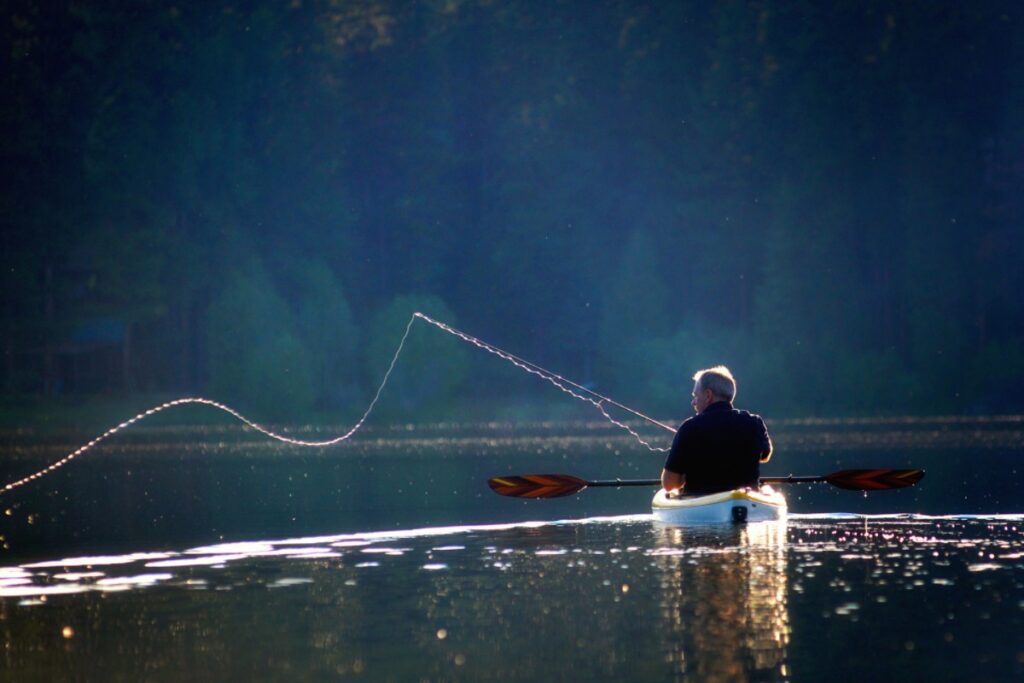
Fishing kayaks are specialized for angling with features like rod holders, gear tracks, and storage for tackle and catches. Stability is a key factor here, and most fishing kayaks are sit-on-top style for ease of movement.
While they’re perfect for anglers, they might be overkill if you’re not into fishing. Top picks in this category would be the Hobie Mirage Pro Angler for pedal-powered fishing and the Old Town Predator for a classic paddle-powered option.
Touring Kayaks
Touring or sea kayaks are designed for distance and open-water conditions. They’re long, narrow, and often have storage compartments for multi-day trips. They offer excellent speed and tracking but might feel less stable to inexperienced paddlers.
Touring kayaks are my go-to for expeditions and extended trips. The Wilderness Systems Tempest and the Necky Chatham are top-tier options in this category.
Top Kayak Brands and Recommendations
While there are numerous kayak brands out there, some have stood out over the years for their commitment to quality, innovation, and performance.
Perception Kayaks
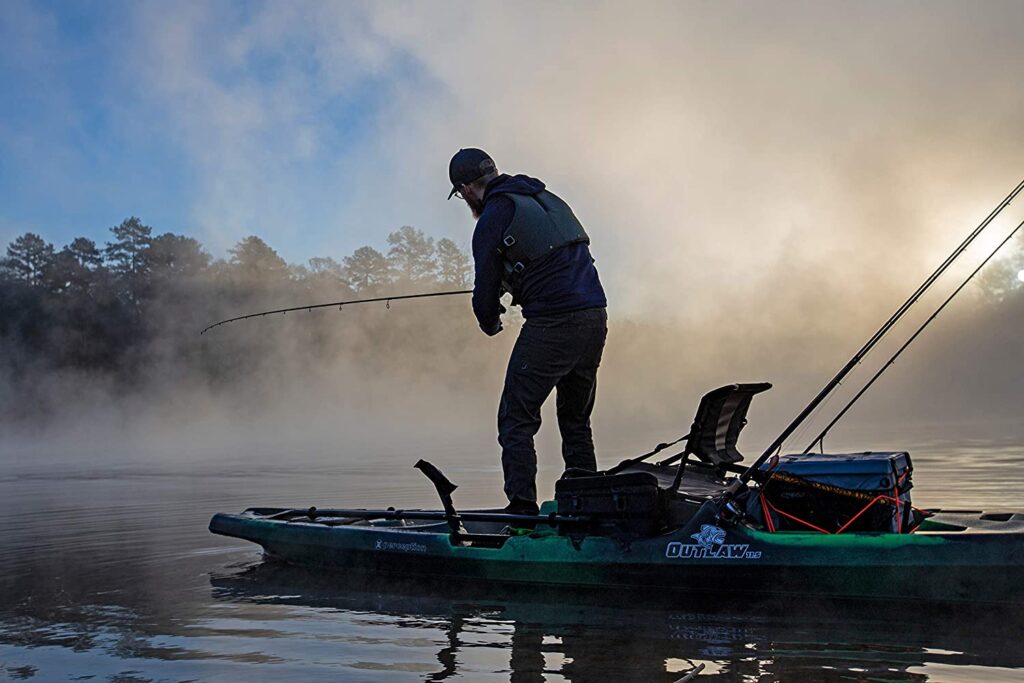
Perception Kayaks is a brand known for producing affordable yet high-quality kayaks suitable for beginners and intermediate paddlers. One of my first kayaks was a Perception model, and it offered an excellent balance between price and performance. For a versatile sit-on-top, the Perception Pescador Pro is a great choice.
Wilderness Systems
Wilderness Systems is another respected name in the kayak world, known for its well-designed and durable kayaks. Their models cover a wide range, from recreational to touring kayaks. If you’re looking for a solid touring kayak, the Wilderness Systems Tempest offers superb performance.
Dagger Kayaks
Dagger is renowned for its whitewater and touring kayaks, boasting excellent design and maneuverability. The Dagger Axis is a versatile sit-in kayak that can handle everything from lakes to rivers.
Advanced Elements
When it comes to inflatable kayaks, Advanced Elements stands out. Their AdvancedFrame kayak offers the convenience of an inflatable model without sacrificing too much on the performance side. I’ve used this kayak on a couple of trips, and its portability is a game-changer.
Hobie
Hobie is a leading brand for fishing and pedal-powered kayaks. Their Mirage Pro Angler, although pricier, is a top-tier fishing kayak. The pedal system allows for hands-free movement, which is a significant advantage when fishing.
Old Town Canoe and Kayak
Old Town is the oldest kayak manufacturer in the world and offers a broad spectrum of models. Their Predator model is a high-quality fishing kayak, and the Dirigo Tandem is perfect for those looking for a two-person kayak.
Picking the right kayak can make all the difference to your paddling experience. With this comprehensive guide to the types of kayaks, their uses, advantages, disadvantages, and the top models available, you’re equipped to make an informed decision that suits your needs. As always, nothing beats testing a few models to find what works best for you.
Essential Kayaking Gear and Equipment
As an experienced kayaker, I can assure you that having the right gear is crucial. It not only enhances your performance on the water but also ensures your safety, which is paramount. Let’s delve into some essential kayaking gear and the role each piece plays.
Paddle
A good paddle is as essential to kayaking as a good pair of hiking boots is to a trek. Your paddle is your motor, and its size, shape, and material can significantly affect your kayaking experience. Remember, a lighter paddle reduces fatigue, and the blade shape can influence power and efficiency.
Personal Flotation Device (PFD) / Life Jacket
A PFD, otherwise known as a life vest or life jacket, is a non-negotiable piece of equipment. It’s designed to provide buoyancy and keep you afloat if you capsize. PFDs for kayaking are specifically designed to not restrict your paddle strokes and often have pockets for gear.
V-Eight PFD offers excellent ventilation, which is a boon for warm-weather paddling.
Helmet
A helmet is crucial for whitewater kayaking, surf kayaking, or any environment where there’s a risk of hitting your head. A good helmet should fit well and offer protection without limiting your vision or hearing.
Spray Skirt
A spray skirt is a waterproof cover that seals the cockpit of a sit-in kayak, keeping you dry and preventing water from entering the kayak. It’s essential for whitewater, sea kayaking, or any cold environment.
Wet Suit/Dry Suit
Depending on the water and air temperature, you might need a wet suit or a dry suit. A wet suit provides thermal insulation by trapping a layer of water against your skin which warms up and keeps you warm. A dry suit, on the other hand, is fully waterproof and worn over insulating layers to keep you dry and warm in colder conditions.
Kayak Roof Rack for Your Vehicle
Unless you’re transporting your kayaks in the bed of a truck or in a trailer, you’ll probably want to consider getting a kayak roof rack for your vehicle.
Roof racks are a safe, secure, and simple way to get your kayaks where you need to go without having to make a huge investment.
Top Kayaking Gear Brands and Recommendations
Finding reliable and comfortable gear is key. Over the years, I’ve come across brands that deliver on quality, durability, and comfort.
I have spent thousands and thousands of dollars of my own money testing different brands and materials, and the following is what I’ve found.
Best Paddles: Werner and Aqua-Bound
Werner and Aqua-Bound are my top recommendations for paddles. Werner’s Camano paddle is an excellent mid-range option, well-balanced and efficient. For a lighter, high-end paddle, the Aqua-Bound Sting Ray Carbon is a fantastic choice.
Best Life Jackets: NRS and Astral
NRS makes reliable and comfortable PFDs. The NRS Chinook is a favorite among paddlers, especially for fishing, due to its comfortable fit and ample pocket space. Astral’s
V-Eight PFD offers excellent ventilation, which is a boon for warm-weather paddling.
Best Helmets: Sweet Protection and WRSI
For helmets, Sweet Protection and WRSI (Whitewater Research and Safety Institute) stand out. The Sweet Protection Strutter helmet offers a great balance of comfort, protection, and style, while the WRSI Current helmet delivers high performance at a lower price point.
Best Spray Skirts: Seals and Snapdragon
Seals make durable spray skirts that fit a wide range of kayak models. The Seals Adventurer has served me well in various conditions. Snapdragon also produces reliable spray skirts, and their Ocean Trek is a great choice for sea kayakers.
Best Wet Suits/Dry Suits: Kokatat and O’Neill
For wet suits and dry suits, Kokatat and O’Neill are leading brands. Kokatat’s Gore-Tex Meridian Dry Suit is a top-of-the-line suit ideal for cold, harsh conditions. O’Neill’s Reactor-2 3/2mm Full Wetsuit is a solid choice for warmer environments.
When choosing gear, remember that comfort and fit are just as important as durability and function. Always try on equipment before purchasing, when possible, and consider renting gear initially to find out what works best for you.
Being properly equipped not only enhances your kayaking experience but can also be a lifesaver in emergency situations. So, invest in high-quality gear – it’s worth every penny.
Kayaking Techniques
The beauty of kayaking lies in the marriage of power and grace, a dance between the paddler and the water.
While you can learn the basics of kayaking quite quickly, mastering advanced techniques can take years of time and practice. We will start from the fundamentals and move up to the more complex maneuvers.
Basic Kayak Paddling Techniques
Mastering the basic paddle strokes is the foundation of becoming a proficient kayaker.
Forward Stroke
The forward stroke is your bread and butter, propelling your kayak ahead. It’s all about rotation from your torso and applying power through your arms. Remember to keep your lower arm almost straight and let the upper arm draw the paddle forward.
Reverse Stroke
The reverse stroke, as the name suggests, is used to paddle backward. Similar to the forward stroke but in reverse, the key is to push with your upper arm while pulling the paddle through the water with your lower arm.
Sweep Stroke
The sweep stroke helps you turn your kayak. For a forward sweep, the blade sweeps wide from the bow to the stern (like a half-circle) helping you pivot. The reverse sweep works in the opposite direction.
Draw Stroke
The draw stroke is used to move your kayak sideways, such as when you want to get closer to a dock or another kayak. You reach out to the side, “draw” the water towards you, and then slice the paddle out to repeat.
Advanced Techniques
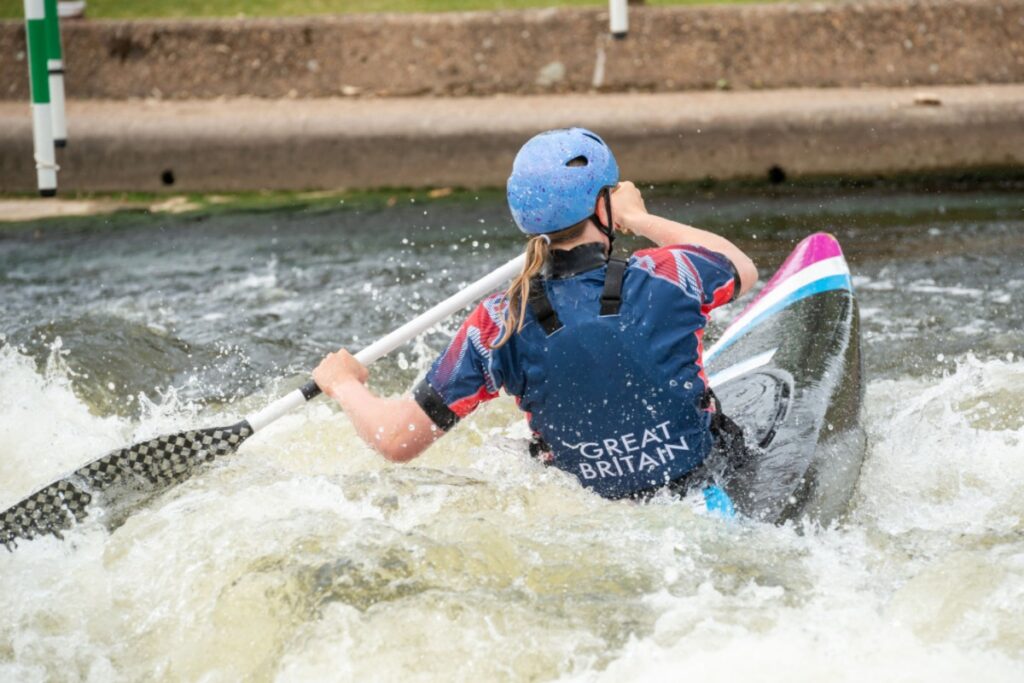
Once you’ve mastered the basics, you’re ready to learn advanced techniques, many of which I’ve found critical when paddling in challenging conditions.
Edging
Edging involves tilting your kayak on its side to aid in turning. By shifting your weight and lifting one knee, you can “edge” the kayak, making it more responsive to turning strokes.
Bracing
Bracing is a stroke that helps prevent capsizing. A low brace (using the back face of the paddle on the water) is effective in stable conditions, while a high brace (front face of the paddle on the water) can be used in rougher waters.
Rolling
Rolling is a self-rescue technique that allows you to right your kayak if you capsize. It involves a specific paddle movement and hip flick. It’s a complex move and usually requires guidance and practice to master.
Rescues
Rescue techniques are crucial for safety. Self-rescues like the paddle float rescue are useful for solo paddlers. Assisted rescues, like the T-rescue, are important when paddling in a group.
Tips and Exercises for Improvement
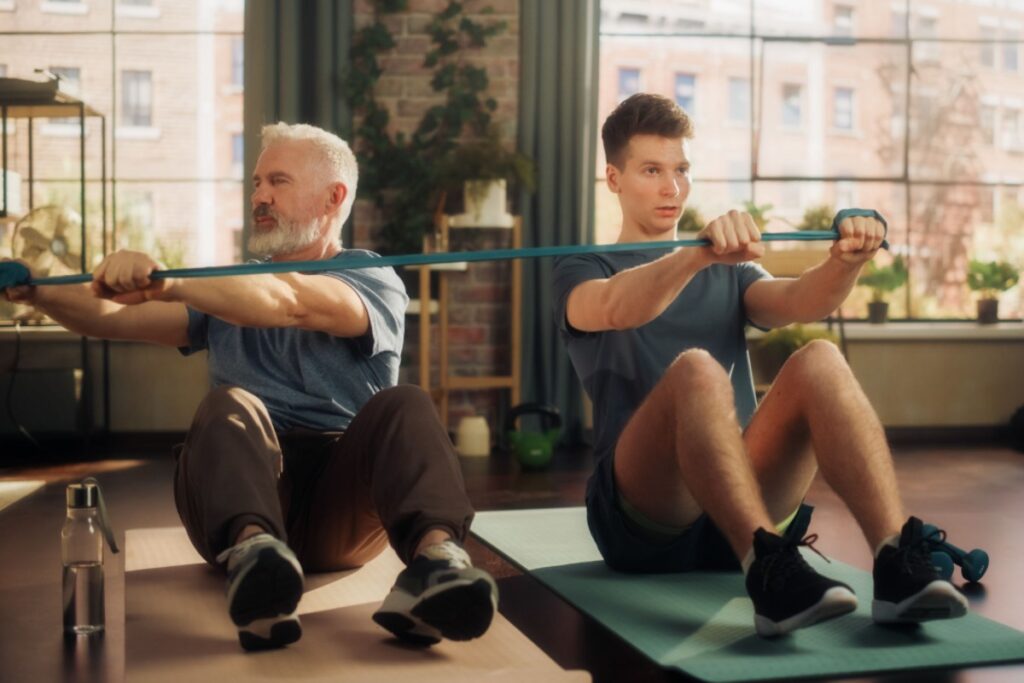
Improving strength, endurance, and technique can take your kayaking to new levels.
- Core Workouts: A strong core is essential for efficient paddling. Exercises like planks, Russian twists, and sit-ups can help strengthen these muscles.
- Cardio Training: Endurance plays a significant role in kayaking, especially on long trips. Regular cardio, like running, cycling, or swimming, can help build this endurance.
- Paddling Drills: Practicing paddling drills on the water is the best way to improve your technique. Focused practice on each stroke, edging, and bracing can help you become a more skilled paddler.
- Rolling Clinics: If you’re struggling to learn rolling, attending a rolling clinic with professional instructors can be very helpful.
- Safety Courses: Enroll in safety courses and learn rescue techniques. Trust me, the confidence knowing that you can handle difficult situations is worth the time and investment.
- Yoga: Flexibility and balance are also crucial for kayaking, and yoga is a great way to improve both. Plus, it’s a relaxing way to unwind after a day on the water!
- Join a Kayak Club: Here, you can learn from more experienced paddlers, find paddling partners, and participate in organized trips.
- Cross-Training: Engage in other outdoor activities such as swimming, hiking, or rock climbing. These not only improve your overall fitness but also help with skills like navigation and risk assessment.
Remember, everyone learns at their own pace, so be patient with yourself.
I’ve spent countless hours on the water, making plenty of mistakes along the way, but every experience was a lesson learned. So, keep practicing, stay safe, and most importantly, enjoy your time on the water. After all, that’s what kayaking is all about!
Potential Risks in Kayaking
Kayaking is a thrilling activity, but it doesn’t come without risks. Over the years, I’ve found that understanding these risks and taking the necessary precautions is the key to safe and enjoyable kayaking adventures.
Capsizing
Regardless of your skill level, capsizing is always a possibility in kayaking. Factors like strong currents, winds, or improper weight distribution can tip a kayak over.
Collisions
Collisions can occur with other watercraft, debris, or natural obstacles like rocks and logs. High speeds, lack of visibility, or misjudging distances can often lead to such accidents.
Hypothermia
Exposure to cold water, especially during fall and winter, can lead to hypothermia, a dangerous drop in body temperature.
Wildlife Interactions
Depending on your location, you might encounter potentially dangerous wildlife. Respect for nature and understanding how to interact with wildlife can minimize these risks.
Staying Safe While Kayaking
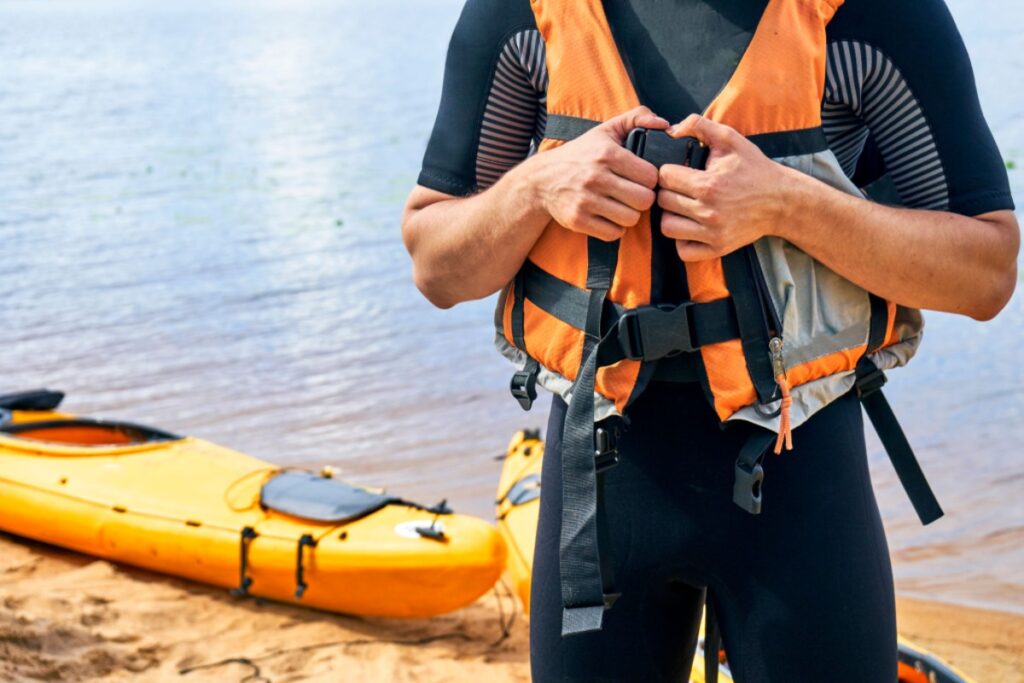
The key to safety lies in preparation, awareness, and appropriate gear. Here are some safety measures every kayaker should follow:
Check Weather and Water Conditions
Always check the weather forecast and water conditions before heading out. Be aware of signs of changing weather and avoid venturing out in strong winds or thunderstorms.
Inform Someone of Your Plans
Before you head out, let someone know where you’re going and when you plan to return. This could be a friend, family member, or local park ranger.
Wear the Right Gear
This includes a well-fitted PFD, appropriate clothing for the water temperature, a helmet (if needed), and sun protection. Don’t forget to pack a whistle for signaling in case of emergencies.
Stay Within Your Skill Level
Avoid paddling in conditions or areas that exceed your skill level. Practice and gradually build up your skills before tackling more challenging waters.
What to Do in Emergency Situations
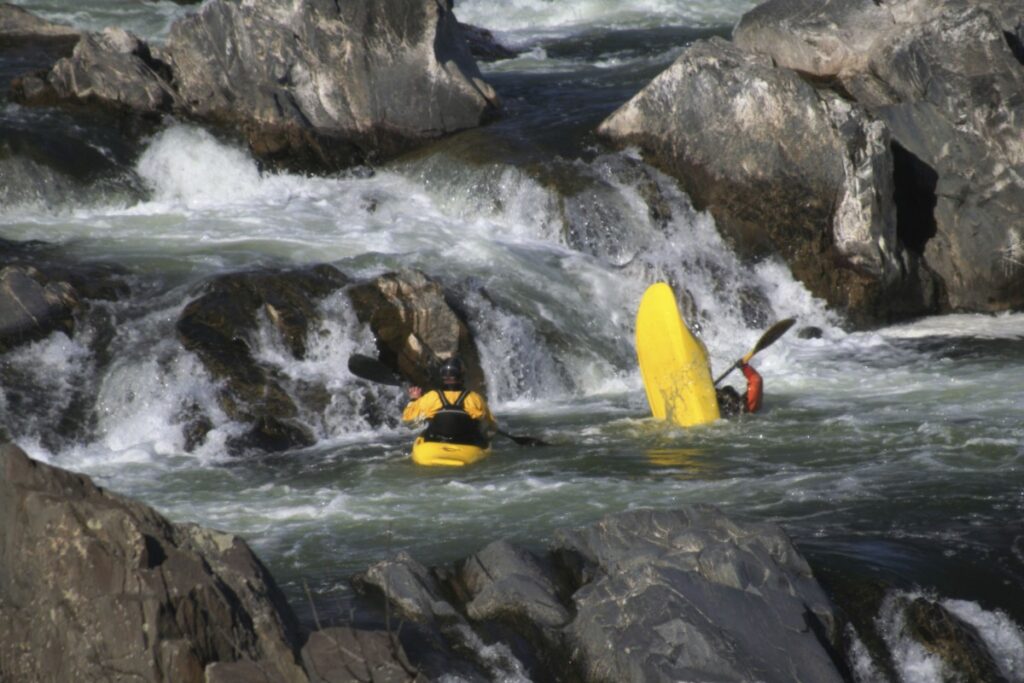
In an emergency, your actions can greatly influence the outcome. Here’s a basic guide to handling common emergency situations:
Capsizing
If you capsize, stay calm. If you’ve learned how to roll, you can right your kayak. If not, exit the kayak, hold onto it if possible, and signal for help.
Collisions
In case of a collision, assess yourself for injuries first, then check the condition of your kayak. If you’re in a high-traffic area, move out of the way of other vessels to avoid further collisions.
Hypothermia
If you or a fellow paddler shows signs of hypothermia (intense shivering, loss of coordination, slurred speech), get out of the water, change into dry clothes, and seek medical help immediately.
Wildlife Encounters
For wildlife encounters, maintain a safe distance and avoid disturbing the animals. If you’re in a region with dangerous wildlife, learn specific procedures for those encounters.
Safety in kayaking is all about preparation, awareness, and calm, decisive action. Taking safety seriously doesn’t take away from the fun – it enhances it by giving you the peace of mind to truly enjoy your adventure.
Knowing Kayaking Rules and Regulations
As kayakers, we have a responsibility to not only protect ourselves but also respect others on the water and preserve the environment we enjoy so much. Knowledge of rules, regulations, and environmental guidelines is crucial in fulfilling these responsibilities.
General Kayaking Rules
There are some general kayaking rules everyone on the water should follow, like staying the right, right of way, and no alcohol or drugs on the water.
Navigation Rules
In most regions, kayakers must follow the International Regulations for Preventing Collisions at Sea (COLREGs). This includes staying to the right when approaching another vessel head-on and yielding to vessels on your right.
Right of Way
Larger vessels have the right of way over smaller ones, and motorized vessels over non-motorized ones.
However, it’s important to be proactive and stay clear of large vessels, as they may not see you or be able to maneuver quickly.
No Alcohol or Drugs
Operating a kayak under the influence of alcohol or drugs is not only dangerous but also illegal in many places.
Make sure you know if your state or particular body of water bans alcohol use before you take any out.
Specific Regulations in Different Regions
Regulations can vary significantly depending on the region or country, and it’s important to be aware of these rules to avoid getting in trouble
Permits and Licensing
Some regions require permits or licenses for kayaking, especially in protected areas or during certain seasons.
Always check local regulations before heading out.
Equipment Regulations
Some places may have specific requirements for safety equipment beyond a PFD, like a sound-making device, lights for nighttime paddling, or a certain type of anchor.
Environmental Guidelines
As lovers of the outdoors, it’s our duty to minimize our impact on the environment. There are also environmental guidelines that we need to abide by to make sure everyone can have a great time on the water.
Leave No Trace Principles
Follow the Leave No Trace principles: take only pictures, leave only footprints.
Avoid disturbing wildlife or vegetation, and always pack out everything you bring in, including trash.
Wildlife Interaction
Always view wildlife from a distance and never feed or disturb animals. Be aware of nesting seasons and avoid landing on beaches that are critical wildlife habitats.
Invasive Species
Clean your gear thoroughly between trips to avoid spreading invasive species, which can wreak havoc on local ecosystems.
Knowing and respecting the rules, regulations, and environmental guidelines will not only keep you out of trouble but also contribute to the preservation of these wonderful places for future generations.
Let’s all do our part to ensure that we can enjoy the beauty and thrill of kayaking for many years to come.
How to Choose a Kayaking Destination
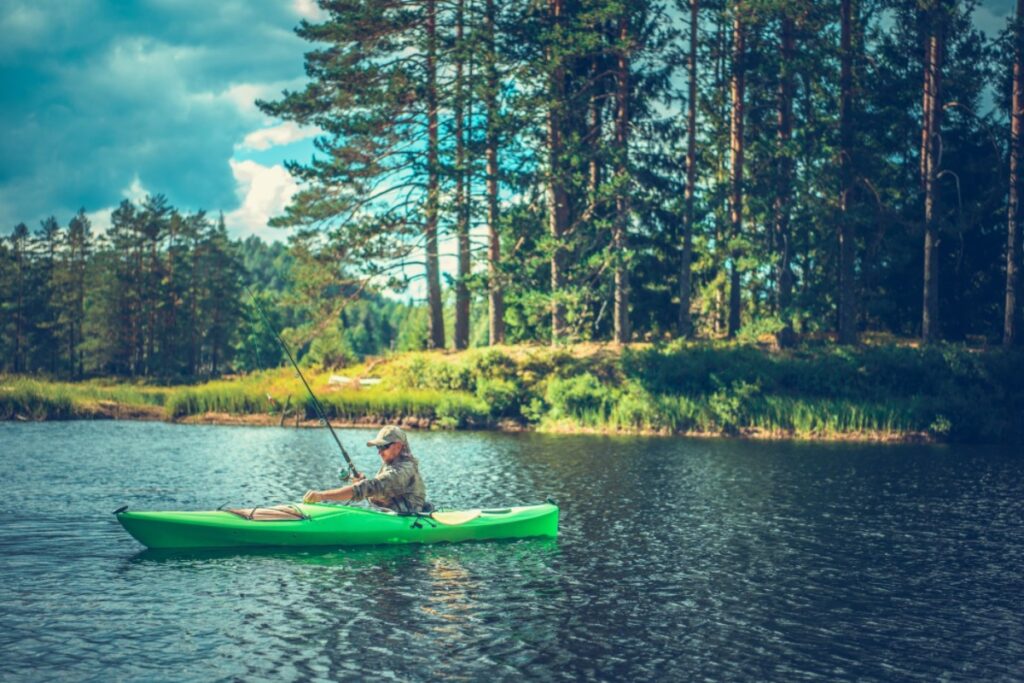
One of the best parts about kayaking is the places it takes you, from serene lakes and winding rivers to stunning coastlines and remote wilderness. But choosing a destination isn’t as simple as pointing to a spot on the map; several factors come into play.
Factors to Consider
Before you just take your kayak out for your first time, or really every time, there are several factors to consider.
Weather and Water Conditions
Check the typical weather patterns and water conditions for the time of year you’re planning to kayak. Remember, conditions can change rapidly, so always have a backup plan.
Difficulty Level
Consider your skill level. Are you comfortable with the type of water (calm lakes, flowing rivers, or open sea)? Can you handle potential challenges like currents, tides, or portages?
Access and Permits
Research if the area is accessible and if any permits are required. Some areas might only be reachable by water, and some protected areas require advanced permits or have restrictions on access.
Local Wildlife and Scenery
Do you want to spot certain wildlife, catch the autumn foliage, or see a particular landmark? Research the best times and places for these experiences.
Top Kayaking Destinations
There are so many great kayaking spots near you that are easily accessible, but if money was no object, here are the top kayaking destinations across the world.
Sea Kayaking in the San Juan Islands, Washington, USA
With a plethora of wildlife, including orcas, seals, and bald eagles, kayaking here is an unforgettable experience. However, the currents and tides demand a solid skill level.
River Kayaking on the Dordogne, France
The Dordogne is perfect for beginners and families, with plenty of picturesque villages and castles along the way. Remember, I once had the best croissant of my life in La Roque-Gageac!
Exploring the Norwegian Fjords, Norway
Kayaking here lets you experience the awe-inspiring scale of these glacially carved valleys. Just be prepared for chilly weather, even in summer.
Wildlife Spotting in the Everglades, Florida, USA
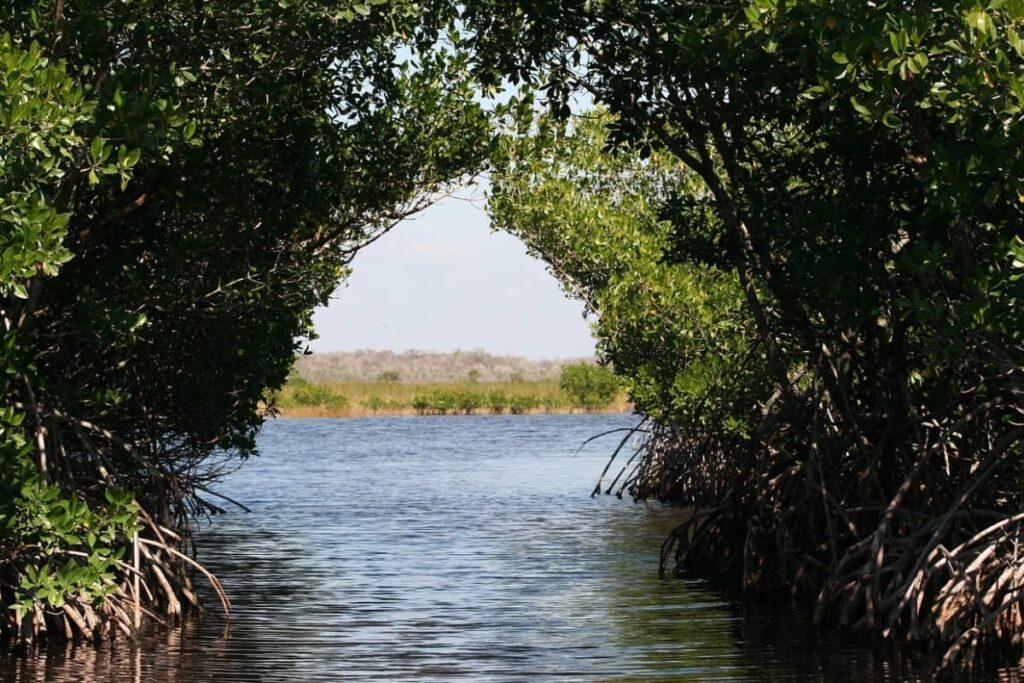
A paddling trail through mangrove tunnels and marshes offers unparalleled birdwatching and encounters with alligators. Make sure to prepare for the mosquitoes!
Choosing a kayaking destination involves a balance between challenge and enjoyment.
Keep in mind your skills, interests, and the local conditions.
But no matter where you go, remember to respect the environment and savor the journey, because, in kayaking, every paddle stroke is an adventure.

